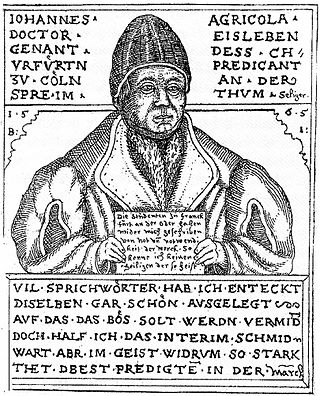
Johann or Johannes Agricola was a German Protestant Reformer during the Protestant Reformation. He was a follower and friend of Martin Luther, who became his antagonist in the matter of the binding obligation of the law on Christians.
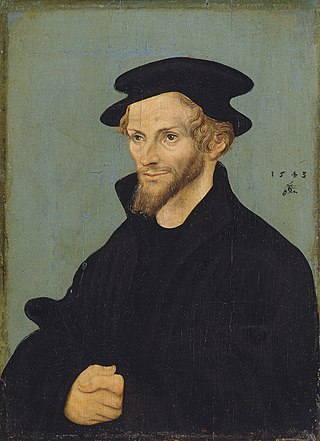
Philip Melanchthon was a German Lutheran reformer, collaborator with Martin Luther, the first systematic theologian of the Protestant Reformation, intellectual leader of the Lutheran Reformation, and an influential designer of educational systems. He stands next to Luther and John Calvin as a reformer, theologian, and shaper of Protestantism.
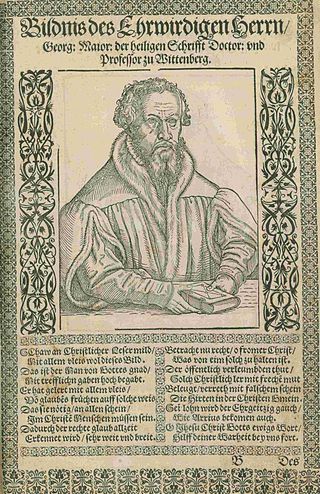
Georg Major was a Lutheran theologian of the Protestant Reformation.

Wittenberg, is the fourth largest town in Saxony-Anhalt, Germany. Wittenberg is situated on the River Elbe, 60 kilometers (37 mi) north of Leipzig and 90 kilometers (56 mi) south-west of Berlin, and has a population of 46,008 (2018).
Wittenberg is a district in the east of Saxony-Anhalt, Germany. Neighboring districts are Anhalt-Bitterfeld, the district-free city of Dessau-Roßlau, the districts of Potsdam-Mittelmark, Teltow-Fläming and Elbe-Elster in Brandenburg, and the district of Nordsachsen in Saxony. The capital and largest city is Wittenberg, famous for its association with the influential religious reformer Martin Luther and containing a UNESCO World Heritage Site.
Crypto-Calvinism is a pejorative term describing a segment of those members of the Lutheran Church in Germany who were accused of secretly subscribing to Calvinist doctrine of the Eucharist in the decades immediately after the death of Martin Luther in 1546. It denotes what was seen as a hidden Calvinist belief, i.e., the doctrines of John Calvin, by members of the Lutheran Church. The term crypto-Calvinist in Lutheranism was preceded by terms Zwinglian and Sacramentarian. Also, Jansenism has been accused of crypto-Calvinism by Roman Catholics.
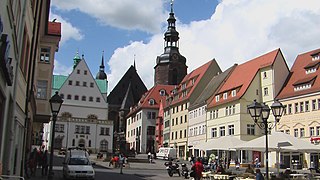
Eisleben is a town in Saxony-Anhalt, Germany. It is famous as both the hometown of the influential theologian Martin Luther and the place where he died; hence, its official name is Lutherstadt Eisleben. First mentioned in the late 10th century, Eisleben is divided into old and new towns, the latter of which was created for Eisleben's miners in the 14th century. As of 2020, Eisleben had a population of 22,668. It lies on the Halle–Kassel railway.
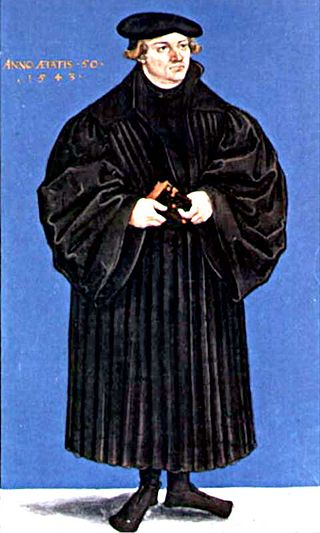
Justus Jonas, the Elder, or simply Justus Jonas, was a German Lutheran theologian and reformer. He was a Jurist, Professor and Hymn writer. He is best known for his translations of the writings of Martin Luther and Philipp Melanchthon. He accompanied Martin Luther in his final moments.
The Philippists formed a party in early Lutheranism. Their opponents were called Gnesio-Lutherans.
Veit Amerbach, was a German Lutheran theologian, scholar and humanist, who converted to Catholicism.

Martin Luther was a German priest, theologian, author, hymnwriter, professor, and Augustinian friar. He is the seminal figure of the Protestant Reformation whose followers became known as Lutherans.

Georg Rhau (Rhaw) was a German publisher and composer. He was one of the most significant music printers in Germany in the first half of the 16th century, during the early period of the Protestant Reformation. He was principally active in Wittenberg, Saxony, the town where Martin Luther is said to have nailed the Ninety-five Theses to the door of the Castle Church, initiating the Reformation. Rhau's support as a printer was critical to Luther's success.
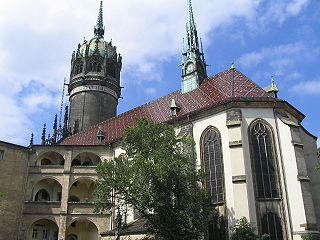
All Saints' Church, commonly referred to as Schlosskirche to distinguish it from the Stadtkirche of St. Mary's – and sometimes known as the Reformation Memorial Church – is a Lutheran church in Wittenberg, Saxony-Anhalt, Germany. It is the site where, according to Philip Melanchthon, the Ninety-five Theses were posted by Martin Luther in 1517, the act that has been called the start of the Protestant Reformation. From 1883 onwards, the church was restored as a memorial site and re-inaugurated on 31 October 1892, 375 years after Luther's posting. Because of its religious significance and testimony to the lasting global effects of the Reformation, the church was inscribed on the UNESCO World Heritage List in 1996 along with other sites in Wittenberg and Eisleben associated with Martin Luther and Philip Melanchthon.

The Stadt- und Pfarrkirche St. Marien zu Wittenberg is the civic church of the German town of Lutherstadt Wittenberg. The reformers Martin Luther and Johannes Bugenhagen preached there and the building also saw the first celebration of the mass in German rather than Latin and the first ever distribution of the bread and wine to the congregation – it is thus considered the mother-church of the Protestant Reformation. In 1996, it was inscribed on the UNESCO World Heritage List along with Castle Church of All Saints (Schlosskirche), the Lutherhaus, the Melanchthonhaus, and Martin's Luther's birth house and death house in Eisleben, because of its religious significance and testimony to the lasting, global influence of Protestantism.

The Lutherhaus is a writer's house museum in Lutherstadt Wittenberg, Germany. Originally built in 1504 as part of the University of Wittenberg, the building was the home of Martin Luther for most of his adult life and a significant location in the history of the Protestant Reformation. Luther was living here when he wrote his 95 Theses.
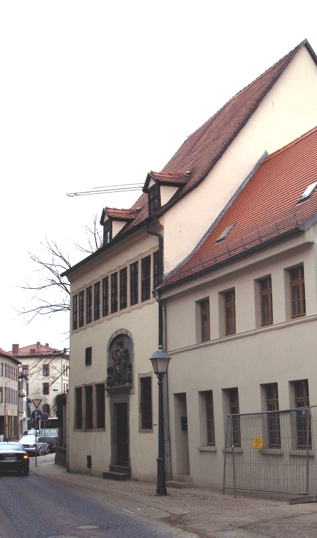
Martin Luther's Birth House is a building and museum in Eisleben, Germany. The German religious reformer Martin Luther was born there in 1483. However, the actual house in which Luther was born no longer exists, it having been burnt completely to the ground in 1689. A new building was built on the original site and was opened to the public in 1693, although it did not adhere to the original floor plan and size of the former house. An excavation was carried out in 2006, revealing pottery sherds and a clay floor from the original house.
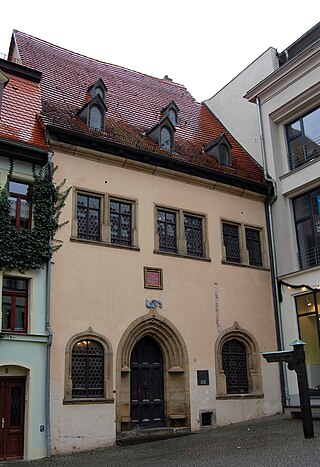
Martin Luther's Death House is an historic building in Eisleben, Saxony-Anhalt Germany, long regarded as the place where the influential theologian Martin Luther died on 18 February 1546. Along with Martin Luther's Birth House in Eisleben and other sites associated with Martin Luther in Wittenberg, the building was inscribed on the UNESCO World Heritage List in 1996. It is now a museum.

Lutherhaus Eisenach is one of the oldest surviving half-timbered houses in Thuringia. Tradition holds that Martin Luther lived there with the Cotta family during his schooldays in Eisenach from 1498 to 1501. The Lutherhaus has been one of the most important historic Reformation sites since the 19th century and, as such, was designated a "European cultural heritage site" in 2011. The Lutherhaus has been run as a cultural history museum since 1956.

St. Augustine's Monastery in Erfurt, central Germany, is a former church and monastery complex dating from the 13th century. The site is almost one hectare in size. It was built by Augustinian friars, an order of the Catholic Church. It is most well known as the former home of Martin Luther (1483–1546), the father of the Reformation, who lived there as a friar from 1505 until 1511.

















